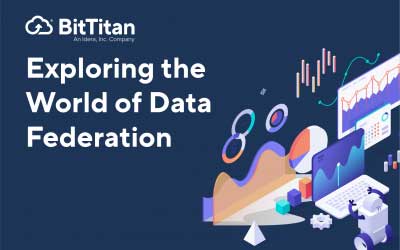Exploring the World of Data Federation
If you hear the word ‘federation’ and it brings to mind some kind of governmental body, you wouldn’t be wrong. The United States is a federation – a collection of states joined together into a single governing body. Star Trek’s fictional Starfleet Command is part of the United Federation of Planets – a vast interstellar alliance of sovereign planets. These examples can help us think about data federation, which is a kind of governing mechanism for joining together disparate databases.
What is a federated database, and why should you care?
A federated database maps multiple autonomous database systems into a single interconnected computer network, allowing them to function as one. Creating a federated database is an alternative to merging several databases together. It can often be set up quickly with no actual data being integrated. All the data from a range of sources can be converted to a common model, providing a single source for front-end applications.
Data federation removes a lot of the problems associated with raw data, saving businesses time and money. Instead of making multiple copies of the same data, data federation can be used to collect and convert data from multiple sources into a single format, eliminating the need for yet another storage system.
It’s all about the collaboration
Just like the variety of lifeforms (human, Vulcan, and otherwise) who’ve come together in Starfleet to explore strange new worlds, today’s Earthlings often need better ways to collaborate and share data. For example, in the case of a company merger or acquisition it may be necessary to inter-connect sections of different tenants without going forward with full integration.
Tools are available to combine multiple servers and databases into a federated database. But Microsoft makes it easy to accomplish inter-tenant collaboration if users on multiple tenants need to see each other’s calendars, work on the same team, or share specific files. Let’s look at some of the possibilities:
Sharing Calendars – It’s sometimes beneficial for different teams to be able to share calendars even when they’re in separate organizations. On Microsoft 365, administrators can set up different levels of calendar access in Exchange Online and let users share free/busy information with others, making it more convenient to plan meetings or assignments.
Access SharePoint or OneDrive – Sharing sites and documents is easy to do with Microsoft 365 on separate tenants, even with external users. Administrators configure sharing at the tenant, or site collection level for Microsoft account authenticated, work or school account authenticated or guest accounts.
Collaborate in Teams – Teams administrators can allow Teams collaboration with users external to the organization. A user admin or global admin for the Microsoft 365 tenant initiates an invitation to collaborate. Global admins and team owners can then invite anyone with an email address to join. Admins can also manage and edit guests already present in the tenant.
MigrationWiz makes it easy to combine tenants in the case of a merger or acquisition. But there are times when an organization isn’t quite ready for a full migration, but still needs to collaborate. That’s when it pays to be using Microsoft 365 with tools that allow admins to set up a federated database and streamline collaboration across tenants.

